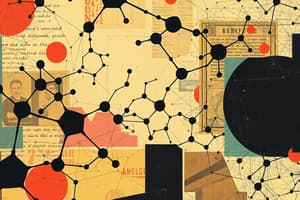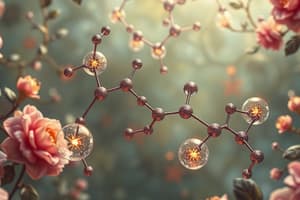Podcast
Questions and Answers
What is a characteristic of covalent bonds?
What is a characteristic of covalent bonds?
- They create ionic charges between molecules.
- They are formed when two atoms share electrons. (correct)
- They occur only between metal atoms.
- They involve the transfer of electrons.
Which of the following describes a polar bond?
Which of the following describes a polar bond?
- Electrons are transferred from one atom to another.
- All molecules in a polar bond are hydrophobic.
- There is a significant difference in electronegativity between the atoms. (correct)
- Electrons are shared equally between two atoms.
What type of molecule does not interact well with water?
What type of molecule does not interact well with water?
- Hydrophobic (correct)
- Hydrophilic
- Polar
- Ionic
What is the primary function of glucose in carbohydrates?
What is the primary function of glucose in carbohydrates?
What is produced during the dehydration synthesis reaction?
What is produced during the dehydration synthesis reaction?
Which type of carbohydrate is formed by two monosaccharides?
Which type of carbohydrate is formed by two monosaccharides?
What is the primary function of glucose in the body?
What is the primary function of glucose in the body?
Which of the following carbohydrates is a disaccharide?
Which of the following carbohydrates is a disaccharide?
What defines an isomer?
What defines an isomer?
What is a key feature of carbon atoms in organic molecules?
What is a key feature of carbon atoms in organic molecules?
What process breaks polymers into monomers by adding water?
What process breaks polymers into monomers by adding water?
Which statement accurately describes glycogen?
Which statement accurately describes glycogen?
What is formed during dehydration synthesis?
What is formed during dehydration synthesis?
What type of carbohydrate is cellulose classified as?
What type of carbohydrate is cellulose classified as?
Which of the following sugars is less sweet than glucose and fructose?
Which of the following sugars is less sweet than glucose and fructose?
Which carbohydrate is primarily involved in energy storage in humans?
Which carbohydrate is primarily involved in energy storage in humans?
Flashcards are hidden until you start studying
Study Notes
Carbon Atoms
- Carbon possesses 4 valence electrons, enabling it to form 4 covalent bonds.
- Common bonding partners for carbon include hydrogen, oxygen, and nitrogen.
Covalent Bonds
- Covalent bonds form through the sharing of electrons between atoms.
- Nonpolar bonds feature equal sharing of electrons (e.g., C-H bonds), while polar bonds involve unequal sharing, leading to partial charges (e.g., O-H bonds).
Molecular Interactions
- Hydrophobic molecules are nonpolar and do not interact well with water.
- Hydrophilic molecules are polar and interact well with water.
Chemical Reactions
- Hydrolysis is a reaction that breaks down molecules through the addition of water (e.g., during digestion).
- Dehydration synthesis builds molecules by removing water, often forming polymers.
Carbohydrates
- Composed of carbon, hydrogen, and oxygen in a 1:2:1 ratio.
- Types of Carbohydrates:
- Monosaccharides: Simple sugars like glucose and fructose.
- Disaccharides: Two monosaccharides linked, such as sucrose.
- Polysaccharides: Long chains of monosaccharides, including starch, glycogen, and cellulose.
Functions of Carbohydrates
- Provide rapid energy, primarily through glucose.
- Serve as energy storage in the form of glycogen in animals and starch in plants.
- Cellulose acts as insoluble fiber aiding digestion.
Isomers
- Isomers are molecules with identical chemical formulas but different structures, such as glucose and fructose.
Hydrolysis and Dehydration Synthesis
- Biological molecules are often polymers made from repeating subunits called monomers.
- Dehydration synthesis connects monomers into polymers while releasing water.
- Hydrolysis breaks down polymers into monomers by adding water, effectively reversing dehydration synthesis.
Monosaccharides
- Basic carbohydrate building blocks, for example:
- Glucose: Primary energy source.
- Fructose: Found in fruits.
- Galactose: Present in yogurt, less sweet than glucose or fructose.
- Ribose: Important for DNA structure.
Disaccharides
- Formed by linking two monosaccharides via a dehydration reaction, resulting in the loss of a water molecule.
- Examples include:
- Sucrose: Table sugar from glucose and fructose.
- Lactose: Sugar in milk from galactose and glucose, which some individuals cannot digest due to low levels of lactase enzyme.
Polysaccharides
- Composed of two or more monosaccharides, functioning as storage or structural components in various organisms.
Studying That Suits You
Use AI to generate personalized quizzes and flashcards to suit your learning preferences.




